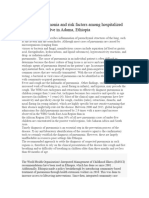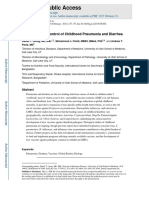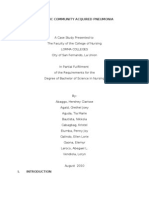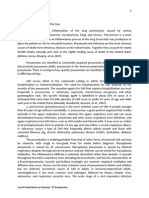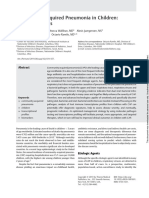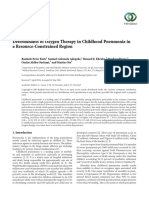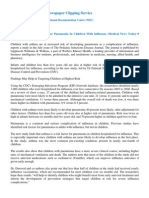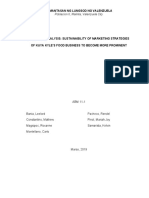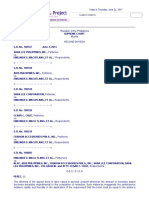Professional Documents
Culture Documents
Awareness On Acute Respiratory Infection Among Mothers of Children Under Five Year
Original Title
Copyright
Available Formats
Share this document
Did you find this document useful?
Is this content inappropriate?
Report this DocumentCopyright:
Available Formats
Awareness On Acute Respiratory Infection Among Mothers of Children Under Five Year
Copyright:
Available Formats
Volume 8, Issue 5, May – 2023 International Journal of Innovative Science and Research Technology
ISSN No:-2456-2165
Awareness on Acute Respiratory Infection among
Mothers of Children Under Five Year
1 2
Dr. Surendra Saha Dr. Akshoola Turusbekova,
Final Year, MPH Student, Professor,
Osh State University, Kyrgystan Osh State University, Kyrgystan
3
Dr. Ravi Roshan Khadka
Professor, Surgery Department,
Jalal-abad State Univeristy, Kyrgystan
Abstract:- Lower respiratory infection includes epiglottitis,
laryngitis, bronchitis, bronchiolitis and pneumonia. 1
Background:
In this study we have considered the level of Acute respiratory infections can occur in any part of
awareness on Acute Respiratory Tract Infection among the respiratory system from the middle ear to the nose to the
the mothers of children under five year of age in Jalal- lungs. Pneumonia is a severe form of acute lower respiratory
abad, Kyrgyzstan. As we know Acute Respiratory infection that specifically affects the lungs. Most acute
Infection is a common diseases and hundreds of children respiratory infections result in mild illnesses, such as the
under age of five they die due ARI in Developing common cold. But in vulnerable children, infections that
countries. So the main objective of this study is to find begin with mild symptoms may sometimes lead to more
out the level of knowledge regarding ARI among mother severe illnesses, such as pneumonia – especially when they
who has at least one child who is under fiver year of age. coincide with other illnesses like diarrhoea or malaria. It is
estimated that more than 150 million episodes of pneumonia
Methods: occur every year among children under five in developing
A cross- sectional study was conducted in which countries, accounting for more than 95 per cent of all new
semi structured close ended questionnaire was used to cases worldwide. Between 11 million and 20 million
collect data from the mother who had at least one child children with pneumonia will require hospitalization, and
who is under fiver year od age. The sampling technique more than 2 million will die from the disease. It is also
used in this study was on the basis of a convenient important to note that incidence of pneumonia among
sampling technique and 280 sample size was taken for children decreases with age.13 South Asia and sub-Saharan
the study. After collecting data, they will entered in SPSS Africa combined bear the burden of more than half of the
software for data analysis. total number of pneumonia episodes worldwide among
children under five. Three quarters of all pneumonia
Conclusion: episodes worldwide among children under five occur in just
Majority of the respondent 55% were from age 15 countries. 2
group above 25-30 and remaining were from (20- 25)
38% and 30-35 years 7.5%. Among the respondents Acute respiratory infections can be attributed to an
who have 2 children were 41.25% and 30% have only interaction between the host, infectious agent, and the
one child and those who have three children were 20% environment. Although 80% of all cases of pneumonia
and the women who have children more than four are examined in hospitals in developing countries are caused by
8.75%. Majority of mother have very good level of two types of bacteria, Streptococcus Pneumonia and
knowledge regarding ARI, whereas 31.1% of the Haemophylus Influenza, most of other infections are of
respondent had good level of awareness regarding ARI viral origin. Other risk factors that encourage the spread of
and remaining 5.9% of them had poor level of knowledge ARI include: low birth weight, malnutrition, poor
about ARI. breastfeeding practices, specific nutritional deficiencies
(especially vitamin A), chilling in young infants, indoor air
Keywords: Awareness, Acute, Pneumonia, Infection, pollution (such as smoke from cooking fuels and tobacco),
Mother, Children. urban air pollution, illiteracy, overcrowding, poor hygiene,
lack of access to health services (especially immunizations),
I. INTRODUCTION and low socioeconomic status. Many of these risk factors
may interact through complex mechanisms to cause
Acute respiratory infection is often classified as Acute subsequent illness. 5
upper respiratory infection (AURI) and Acute lower
respiratory infection (ALRI). Upper respiratory infections Caregivers will need to seek appropriate medical care
include common cold, pharyngitis, and otitis media. immediately for children with signs of pneumonia. Only
about 1 in 5 caregivers knows the danger signs of
IJISRT23MAY114 www.ijisrt.com 1057
Volume 8, Issue 5, May – 2023 International Journal of Innovative Science and Research Technology
ISSN No:-2456-2165
pneumonia; only about half of children sick with pneumonia Study Area:
receive appropriate medical care; and, according to the Group of family doctors polyclinic 3, Jalalabad,
limited data available, less than 20 per cent of children with KyrgyzstanStudy duration:
pneumonia received antibiotics, the recommended
treatment. Effective interventions to reduce pneumonia Month of December, 2022
deaths are available, but reach too few children. Scaling up
treatment coverage is possible, and at relatively low cost. Study Population:
Estimates suggest that if antibiotic treatment were Mothers with children under five who had visited
universally delivered to children with pneumonia, around outpatient department of group of family doctors polyclinic.
600,000 lives could be saved each year, at a cost of $600
million.1 Furthermore, the number of lives saved could Sample Size:
more than double to 1.3 million if both prevention and
238 Sample Size were Collected
treatment interventions to reduce pneumonia deaths were
universally delivered. 2
Selection CriteriaInclusion Criteria:
All the women who had child under 5yr and who were
Research Question/Problem Statement
present at the policlinic with the problem of ARI with their
What is the level of awareness on Acute Respiratory
child with diagnosis of influenza.
Infection among mothers of children under five?
Exclusion Criteria:
Objectives of the Study
Those who refused to participate in the study.
Those who were unable to provide information due to
General Objective
physically or mentally illness.
To find out the level of awareness about acute
respiratory infection among the mothers with children under
Sampling Technique:
five.
Non Probability sampling method was applied for this
studyA structured (open and close ended) questionnaire.
II. RESEARCH METHODOLOGY
Method of Data Collection:
Study Design:
A cross sectional study was carried out to find the level Data was collected by face to face interview with
of awareness about acute respiratory infection among mother whose children were affected by ARI,(under
mothers with children under five. 5years)
Before taking face to face interview, their consent and
convenience were ensured withproper confidentiality.
III. RESULTS OF THE STUDY
Socio Demographic Characteristics:
Table 1 Distribution of Respondents by Age of Mother who had Child with Under Five Year Child
Age Frequency(n) Percentage (%)
20-25yrs 90 37.8
25-30yrs 130 54.6
30-35yrs 18 7.5
Total 238 100.0
Table 1 shows majority of 55% of the respondent were from age group 25-30 and remaining were from (20- 25) 38% and
30-35 years 7.5%.
Table 2 Distribution of Respondents by Ethnicity
Religion Frequency(n) Percentage (%)
Muslim 230 96.6%
Other 8 3.4%
Total 238 100.0
The above table shows 96.6% were Muslim and remaining 3.4 % were from other religion.
IJISRT23MAY114 www.ijisrt.com 1058
Volume 8, Issue 5, May – 2023 International Journal of Innovative Science and Research Technology
ISSN No:-2456-2165
Fig 1 Distribution of Respondents according to No of Children
Above figure shows that respondents who have 2 children were 41.25% and 30% have only one child and those who have
three children were 20% and the women who have children more than four are 8.75%.
Fig 2 Distribution of Respondents according to Types of Family
Above figure shows that 56.2% women have to stay in joint family and the remaining 43.8%they have to stay as a nuclear.
Table 3 Distribution of Respondents by their Occupation
Occupation Frequency(n) Percentage (%)
Housewife 182 76.4%
Job Holders 56 23.5%
Total 238 100.0
Table 3 Shows that among respondents the majority of women 76.4% are housewife andremaining 23.5 % are engaged
in some job.
IJISRT23MAY114 www.ijisrt.com 1059
Volume 8, Issue 5, May – 2023 International Journal of Innovative Science and Research Technology
ISSN No:-2456-2165
Fig 3 Distribution of Respondents by Presence of Chimney in their House
Above figure shows that 61.2% respondents doesn’t have smoking outlet (chimney) at their house and 38.8% have smoking
outlet.
Table 4 Distribution of Respondents by Level of Awareness in ARI
Level of awareness Frequency(n) Percentage (%)
Very good 150 63%
Good 74 31.1%
Poor 14 5.9%
Total 238 100.0
Above table shows that majority of mother have very appropriate information to the client.
good level of knowledge regarding ARI, whereas 31.1% of
the respondent had good level of awareness regarding ARI This kind of study in large scale which represents the
and remaining 5.9% of them had poor level of knowledge population of the districts or regions could be a useful
about ARI. tool for the planning and implementation of child health
care programme.
IV. CONCLUSION
REFERENCES
The Study Concluded that:
Most of the respondents had heard about ARI and it is [1]. Park, k Preventive and Social Medicine 19th ed.
the major problems of childrenunder five years. M/S Banarasidas Bhanot Publishers 2007; Pp142-
Almost half of participants were found unaware of 144.
signs/symptoms and causes of ARI though they had [2]. UNICEF & WHO, Pneumonia: The forgotten
heard about ARI are major problem in children. killer of children 2006;retrived from www.unicef.
Most of the respondents are unaware of risk factors of org/.../index_3562 6.html
ARI, though it is preventablediseases. [3]. World Health Statistics 2009
More than half of the respondents had good level of [4]. Nepal Demographic and Health Survey 2001,
awareness regarding ARI. Population Division, Ministry of Health and
Population, Government of Nepal, Kathmandu,
RECOMMENDATIONS Nepal and Macro International, Maryland Calverton
[5]. Benti D, Kansal A, Khandewal S, Acute respiratory
Awareness campaign and BCC regarding ARI should be infection in developing countries,2002;retrived from
conducted using appropriate medias i.e. radio, television, http://dcc2.bumc.bu.edu/ih887/presentations98/ari-
magazines, pamphlets. txt.htm
[6]. Nepal Demographic and Health Survey 2006,
Proper awareness is necessary to the community people Population Division, Ministry of Health and
which can be given in the hospital during follow-up.
Population, Government of Nepal, Kathmandu,
Proper training as well as proper environment is Nepal and Macro International, Maryland Calverton.
necessary for the health worker so that they can provide
IJISRT23MAY114 www.ijisrt.com 1060
Volume 8, Issue 5, May – 2023 International Journal of Innovative Science and Research Technology
ISSN No:-2456-2165
[7]. Onta SR, Yengden B. What Do Mothers Know about
Acute Respiratory Infection : a case from Eastern
Nepal. Journal of the Institute of Medicine,
2003;retrived from http://jiom.com.np/index.php
[8]. Siswanto, E, Knowledge and Perception of
Pneumonia Disease among Mothers of Children
Under Five. (Masters Thesis Mahidol University,
Thailand, 2007; Retrived from
http:/mulllinet10.li.mahidol.ac.th/e-thesis.
[9]. Denno et al, A study of mothers knowledge, attitudes
and practices regarding ARI in their children in urban
Ghana. Maternal Knowledge Attitude and Practices
Regarding Childhood ARI in Kumasi, Ghana. Ann
Trop Paediatr. 1994;14(4)); retrived from
www.ncbi.nlm.nih.gov/pubmed
[10]. Rashid, et al, Acute respiratory infections in rural
Bangladesh: cultural understandings, practices and
the role of mothers and community health volunteers
Tropical Medicine and International Health.
2001;6(4). pp 249±255,retrived from
www.ncbi.nlm.nih.gov/pubmed/11348514
[11]. Chan, G. C. & Tang, S. F. Parental knowledge,
attitudes and antibiotic use for acute upper
respiratory tract infection in children. Singapore
Medical Journal 2006; 47(4) Retrived from
www.sma.org.sg/smj
[12]. Gupta et al, an evaluation of Diarrhoeal Disease &
ARI Control Programme in Delhi Slum Indian
Journal of Paediatrics.2007;74(5) retrived from
www.springerlink.com/content
[13]. Gálvez, et alPeruvian mothers’ knowledge and
recognition of pneumonia in children under 5 years
of age Rev Panam Salud Publica/Pan Am J Public
Health 2002; 11(2) retrived from
www.scielosp.org/pdf/rpsp/v11n2/8380.pdf
[14]. Chatterjee, S. A study of epidemiological factors
related to ARI in under five children attending the
immunization clinic. Internet journal of pulmonary
medicine. 2007; 7(2).retrived from www.ispub.com
[15]. Jain S.K Khan, J. A Epidemioplgical study of Acute
Diarrhoeal Disease and Acute Respiratory Infection
amongst under Five Children .Indian Journal for the
Practicing Doctor.200; 3(5) retrived from
www.indmedica.com/journals.php
[16]. Central Bureau of Statistics , Ramshah Path,
Kathmandu, Nepal: Statistical Pocket Book
Nepal.2010 June [cited June 7]: Available from:
URL:
http://en.wikipedia.org/wiki/Demographics_of_Nepal
#Ethnicity
[17]. Basic indication of Nepal. UNICEF 2003-2007 [cited
on 2010 April 30]. Available from: URL:
http://www.unicef.org/infobycountry/nepal_nepal_st
atistics.html#70
IJISRT23MAY114 www.ijisrt.com 1061
You might also like
- Keywords:-URI, Infection, Respiratory System, STP,: Mothers, Under Five ChildrenDocument9 pagesKeywords:-URI, Infection, Respiratory System, STP,: Mothers, Under Five ChildrenInternational Journal of Innovative Science and Research TechnologyNo ratings yet
- 12701-50629-1-PB-1 AnakDocument4 pages12701-50629-1-PB-1 AnakAni RoseNo ratings yet
- JCDR 10 LC08Document6 pagesJCDR 10 LC08kurniawan martNo ratings yet
- Wheez ChestDocument12 pagesWheez ChestmelisaberlianNo ratings yet
- Research. ReviewedDocument14 pagesResearch. Reviewednjukierick03No ratings yet
- ZNJ - Volume 17 - Issue 2 - Pages 1-13Document13 pagesZNJ - Volume 17 - Issue 2 - Pages 1-13Ljc JaslinNo ratings yet
- PediatricsDocument21 pagesPediatricsLuis ArrietaNo ratings yet
- Chapter 1 MagbagoDocument7 pagesChapter 1 MagbagoAbbie DualanNo ratings yet
- 1 s2.0 S0929664621003892 MainDocument8 pages1 s2.0 S0929664621003892 Mainrheynamaulidar rumoninNo ratings yet
- 01 ProjectDocument30 pages01 Projectkarunyabathula100% (1)
- Ajol File Journals - 494 - Articles - 112516 - Submission - Proof - 112516 5833 312396 1 10 20150204Document6 pagesAjol File Journals - 494 - Articles - 112516 - Submission - Proof - 112516 5833 312396 1 10 20150204ASK De OliveiraNo ratings yet
- ResearchDocument3 pagesResearchBontuNo ratings yet
- First Line FluDocument6 pagesFirst Line Flu419022 MELA ANANDA PUTRIANANo ratings yet
- 2013 34 438 Rani S. Gereige and Pablo Marcelo Laufer: Pediatrics in ReviewDocument21 pages2013 34 438 Rani S. Gereige and Pablo Marcelo Laufer: Pediatrics in ReviewAlvaro Andres Flores JimenezNo ratings yet
- Research Paper On Microbial DiseasesDocument3 pagesResearch Paper On Microbial DiseasesMaui Vecinal de GuzmanNo ratings yet
- Wheezing in Children Approaches To Diagnosis and MDocument6 pagesWheezing in Children Approaches To Diagnosis and MMemory LastNo ratings yet
- Management of Acute Respiratory Diseases PDFDocument21 pagesManagement of Acute Respiratory Diseases PDFFernandoXavierNo ratings yet
- HHS Public Access: Prevention and Control of Childhood Pneumonia and DiarrheaDocument16 pagesHHS Public Access: Prevention and Control of Childhood Pneumonia and DiarrheagemzeddNo ratings yet
- Jurnal Seasonal Influenza Vaccination Among Older Adults in Jordan Prevalence Knowledge and AttitudesDocument6 pagesJurnal Seasonal Influenza Vaccination Among Older Adults in Jordan Prevalence Knowledge and AttitudesMusdaliva Tri Riskiani AlminNo ratings yet
- New MOC ResourcesDocument22 pagesNew MOC ResourcesYidnekachew Girma AssefaNo ratings yet
- Gereige 2013 PneumoniaDocument21 pagesGereige 2013 PneumoniaLuis Carlos OlguínNo ratings yet
- Respiratory in PakDocument10 pagesRespiratory in PakEman ShNo ratings yet
- Jurnal Pneumonia InternasionalDocument8 pagesJurnal Pneumonia InternasionalDina AryaniNo ratings yet
- Pneumonia: Practice GapDocument21 pagesPneumonia: Practice GaptamaNo ratings yet
- Community Acquired Pneumonia, A Case StudyDocument26 pagesCommunity Acquired Pneumonia, A Case StudyMenggay SanDiego57% (7)
- Pneumonias in Children Practical Policies For StudentsDocument45 pagesPneumonias in Children Practical Policies For StudentsIbtissame BadadNo ratings yet
- Cep 2020 00339Document23 pagesCep 2020 00339Elison J PanggaloNo ratings yet
- Local Studies and LiteratureDocument9 pagesLocal Studies and LiteratureKarl GutierrezNo ratings yet
- Review: Jacquie N Oliwa, Jamlick M Karumbi, Ben J Marais, Shabir A Madhi, Stephen M GrahamDocument9 pagesReview: Jacquie N Oliwa, Jamlick M Karumbi, Ben J Marais, Shabir A Madhi, Stephen M GrahamirenaNo ratings yet
- PnuemoniaDocument102 pagesPnuemoniaRegineCuasSulibNo ratings yet
- Pediatric Asthma A Global EpidemicDocument6 pagesPediatric Asthma A Global EpidemicburhangunawanNo ratings yet
- AnnMedHealthSciRes4195-3114991 083909 2 PDFDocument5 pagesAnnMedHealthSciRes4195-3114991 083909 2 PDFHIDAYATUL RAHMINo ratings yet
- Lowerrespiratory Tractinfections: Anne B. Chang,, Christina C. Chang,, K. O'Grady,, P.J. TorzilloDocument19 pagesLowerrespiratory Tractinfections: Anne B. Chang,, Christina C. Chang,, K. O'Grady,, P.J. Torzilloshrey keyalNo ratings yet
- Association Between Nutritional Status and Severity of Pneumonia Among Children Under Five Years Attending Wangaya District HospitalDocument7 pagesAssociation Between Nutritional Status and Severity of Pneumonia Among Children Under Five Years Attending Wangaya District HospitalchairulNo ratings yet
- Community-Acquired Pneumonia in Children: Myths and FactsDocument4 pagesCommunity-Acquired Pneumonia in Children: Myths and FactsFranciscoDelgadoNo ratings yet
- PARK Pneumonia SPMDocument15 pagesPARK Pneumonia SPMCh RajeshNo ratings yet
- Pharyngitis Case ReportDocument4 pagesPharyngitis Case ReportMelissa TiofanNo ratings yet
- Neumonia Por InfluenzaDocument19 pagesNeumonia Por InfluenzaEdgar GavilanesNo ratings yet
- Clinical Profile of Acute BronchiolitisDocument4 pagesClinical Profile of Acute BronchiolitisInternational Journal of Innovative Science and Research TechnologyNo ratings yet
- Determinants of Upper Respiratory Tract Infection Among The Under Five ChildrenDocument8 pagesDeterminants of Upper Respiratory Tract Infection Among The Under Five ChildrenInternational Journal of Innovative Science and Research TechnologyNo ratings yet
- Literature ToddlerDocument4 pagesLiterature ToddlerValarmathiNo ratings yet
- Ifransiska,+1 +yustiniDocument6 pagesIfransiska,+1 +yustiniGhan PrathamaNo ratings yet
- Fped 09 599500Document8 pagesFped 09 599500Safira SalsabilaNo ratings yet
- MAN 202 Analysis of Health IssueDocument3 pagesMAN 202 Analysis of Health IssueHectority PlaysNo ratings yet
- 5398-Article Text-66016-1-10-20220526Document14 pages5398-Article Text-66016-1-10-20220526Zulaikha NAIMINo ratings yet
- 1331907497-Montasseretal 2011BJMMR1038Document12 pages1331907497-Montasseretal 2011BJMMR1038puppyhandaNo ratings yet
- In ChildrenDocument7 pagesIn ChildrenJames LopezNo ratings yet
- The Prevalence of Soil Transmitted Helminthiasis Among Filipino Pregnant Women Determined by FecalysisDocument11 pagesThe Prevalence of Soil Transmitted Helminthiasis Among Filipino Pregnant Women Determined by FecalysisCha GuingabNo ratings yet
- Community Acquired PneumoniaDocument4 pagesCommunity Acquired PneumoniaKenPedreso100% (2)
- DynamedDocument41 pagesDynamedkaren AlvaradoNo ratings yet
- Complications and Recommendations in Pregnant Women Infected With Coronavirus Systematic ReviewDocument5 pagesComplications and Recommendations in Pregnant Women Infected With Coronavirus Systematic ReviewInternational Journal of Innovative Science and Research TechnologyNo ratings yet
- Diseases - Asthma Is Key Risk Factor For Pneumonia in Children With Influenza (Medical News Today-9 July 2010)Document1 pageDiseases - Asthma Is Key Risk Factor For Pneumonia in Children With Influenza (Medical News Today-9 July 2010)National Child Health Resource Centre (NCHRC)No ratings yet
- Abstract PneumoniaDocument2 pagesAbstract PneumoniaAlissa MaghopoyNo ratings yet
- Infectious Pediatric Pneumonia: Author: Roberta D. Hood, HBSC, MD, CCFP Date Created: December 2011Document137 pagesInfectious Pediatric Pneumonia: Author: Roberta D. Hood, HBSC, MD, CCFP Date Created: December 2011Kartika Rezky100% (1)
- Jurnal 1Document8 pagesJurnal 1aziskarnNo ratings yet
- Influenza vaccination: What does the scientific proof say?: Could it be more harmful than useful to vaccinate indiscriminately elderly people, pregnant women, children and health workers?From EverandInfluenza vaccination: What does the scientific proof say?: Could it be more harmful than useful to vaccinate indiscriminately elderly people, pregnant women, children and health workers?No ratings yet
- Vaccines: Making the Right Choice for Your ChildFrom EverandVaccines: Making the Right Choice for Your ChildRating: 5 out of 5 stars5/5 (2)
- Clinically Relevant Mycoses: A Practical ApproachFrom EverandClinically Relevant Mycoses: A Practical ApproachElisabeth PresterlNo ratings yet
- Food Protein Induced Enterocolitis (FPIES): Diagnosis and ManagementFrom EverandFood Protein Induced Enterocolitis (FPIES): Diagnosis and ManagementTerri Faye Brown-WhitehornNo ratings yet
- Vaccines: Does herd immunity justify permanent impairment for a few?From EverandVaccines: Does herd immunity justify permanent impairment for a few?No ratings yet
- Designing Cost-Effective SMS based Irrigation System using GSM ModuleDocument8 pagesDesigning Cost-Effective SMS based Irrigation System using GSM ModuleInternational Journal of Innovative Science and Research TechnologyNo ratings yet
- Effect of Solid Waste Management on Socio-Economic Development of Urban Area: A Case of Kicukiro DistrictDocument13 pagesEffect of Solid Waste Management on Socio-Economic Development of Urban Area: A Case of Kicukiro DistrictInternational Journal of Innovative Science and Research TechnologyNo ratings yet
- Utilization of Waste Heat Emitted by the KilnDocument2 pagesUtilization of Waste Heat Emitted by the KilnInternational Journal of Innovative Science and Research TechnologyNo ratings yet
- Impact of Stress and Emotional Reactions due to the Covid-19 Pandemic in IndiaDocument6 pagesImpact of Stress and Emotional Reactions due to the Covid-19 Pandemic in IndiaInternational Journal of Innovative Science and Research TechnologyNo ratings yet
- An Overview of Lung CancerDocument6 pagesAn Overview of Lung CancerInternational Journal of Innovative Science and Research TechnologyNo ratings yet
- Digital Finance-Fintech and it’s Impact on Financial Inclusion in IndiaDocument10 pagesDigital Finance-Fintech and it’s Impact on Financial Inclusion in IndiaInternational Journal of Innovative Science and Research TechnologyNo ratings yet
- Auto Tix: Automated Bus Ticket SolutionDocument5 pagesAuto Tix: Automated Bus Ticket SolutionInternational Journal of Innovative Science and Research TechnologyNo ratings yet
- Predictive Analytics for Motorcycle Theft Detection and RecoveryDocument5 pagesPredictive Analytics for Motorcycle Theft Detection and RecoveryInternational Journal of Innovative Science and Research TechnologyNo ratings yet
- Computer Vision Gestures Recognition System Using Centralized Cloud ServerDocument9 pagesComputer Vision Gestures Recognition System Using Centralized Cloud ServerInternational Journal of Innovative Science and Research TechnologyNo ratings yet
- Ambulance Booking SystemDocument7 pagesAmbulance Booking SystemInternational Journal of Innovative Science and Research TechnologyNo ratings yet
- Cyber Security Awareness and Educational Outcomes of Grade 4 LearnersDocument33 pagesCyber Security Awareness and Educational Outcomes of Grade 4 LearnersInternational Journal of Innovative Science and Research TechnologyNo ratings yet
- Parastomal Hernia: A Case Report, Repaired by Modified Laparascopic Sugarbaker TechniqueDocument2 pagesParastomal Hernia: A Case Report, Repaired by Modified Laparascopic Sugarbaker TechniqueInternational Journal of Innovative Science and Research TechnologyNo ratings yet
- An Industry That Capitalizes Off of Women's Insecurities?Document8 pagesAn Industry That Capitalizes Off of Women's Insecurities?International Journal of Innovative Science and Research TechnologyNo ratings yet
- Unmasking Phishing Threats Through Cutting-Edge Machine LearningDocument8 pagesUnmasking Phishing Threats Through Cutting-Edge Machine LearningInternational Journal of Innovative Science and Research TechnologyNo ratings yet
- Factors Influencing The Use of Improved Maize Seed and Participation in The Seed Demonstration Program by Smallholder Farmers in Kwali Area Council Abuja, NigeriaDocument6 pagesFactors Influencing The Use of Improved Maize Seed and Participation in The Seed Demonstration Program by Smallholder Farmers in Kwali Area Council Abuja, NigeriaInternational Journal of Innovative Science and Research TechnologyNo ratings yet
- Study Assessing Viability of Installing 20kw Solar Power For The Electrical & Electronic Engineering Department Rufus Giwa Polytechnic OwoDocument6 pagesStudy Assessing Viability of Installing 20kw Solar Power For The Electrical & Electronic Engineering Department Rufus Giwa Polytechnic OwoInternational Journal of Innovative Science and Research TechnologyNo ratings yet
- Forensic Advantages and Disadvantages of Raman Spectroscopy Methods in Various Banknotes Analysis and The Observed Discordant ResultsDocument12 pagesForensic Advantages and Disadvantages of Raman Spectroscopy Methods in Various Banknotes Analysis and The Observed Discordant ResultsInternational Journal of Innovative Science and Research TechnologyNo ratings yet
- Smart Health Care SystemDocument8 pagesSmart Health Care SystemInternational Journal of Innovative Science and Research TechnologyNo ratings yet
- Blockchain Based Decentralized ApplicationDocument7 pagesBlockchain Based Decentralized ApplicationInternational Journal of Innovative Science and Research TechnologyNo ratings yet
- Smart Cities: Boosting Economic Growth Through Innovation and EfficiencyDocument19 pagesSmart Cities: Boosting Economic Growth Through Innovation and EfficiencyInternational Journal of Innovative Science and Research TechnologyNo ratings yet
- Impact of Silver Nanoparticles Infused in Blood in A Stenosed Artery Under The Effect of Magnetic Field Imp. of Silver Nano. Inf. in Blood in A Sten. Art. Under The Eff. of Mag. FieldDocument6 pagesImpact of Silver Nanoparticles Infused in Blood in A Stenosed Artery Under The Effect of Magnetic Field Imp. of Silver Nano. Inf. in Blood in A Sten. Art. Under The Eff. of Mag. FieldInternational Journal of Innovative Science and Research TechnologyNo ratings yet
- Visual Water: An Integration of App and Web To Understand Chemical ElementsDocument5 pagesVisual Water: An Integration of App and Web To Understand Chemical ElementsInternational Journal of Innovative Science and Research TechnologyNo ratings yet
- Insights Into Nipah Virus: A Review of Epidemiology, Pathogenesis, and Therapeutic AdvancesDocument8 pagesInsights Into Nipah Virus: A Review of Epidemiology, Pathogenesis, and Therapeutic AdvancesInternational Journal of Innovative Science and Research TechnologyNo ratings yet
- Compact and Wearable Ventilator System For Enhanced Patient CareDocument4 pagesCompact and Wearable Ventilator System For Enhanced Patient CareInternational Journal of Innovative Science and Research TechnologyNo ratings yet
- Air Quality Index Prediction Using Bi-LSTMDocument8 pagesAir Quality Index Prediction Using Bi-LSTMInternational Journal of Innovative Science and Research TechnologyNo ratings yet
- Predict The Heart Attack Possibilities Using Machine LearningDocument2 pagesPredict The Heart Attack Possibilities Using Machine LearningInternational Journal of Innovative Science and Research TechnologyNo ratings yet
- An Analysis On Mental Health Issues Among IndividualsDocument6 pagesAn Analysis On Mental Health Issues Among IndividualsInternational Journal of Innovative Science and Research TechnologyNo ratings yet
- Parkinson's Detection Using Voice Features and Spiral DrawingsDocument5 pagesParkinson's Detection Using Voice Features and Spiral DrawingsInternational Journal of Innovative Science and Research TechnologyNo ratings yet
- Quantifying of Radioactive Elements in Soil, Water and Plant Samples Using Laser Induced Breakdown Spectroscopy (LIBS) TechniqueDocument6 pagesQuantifying of Radioactive Elements in Soil, Water and Plant Samples Using Laser Induced Breakdown Spectroscopy (LIBS) TechniqueInternational Journal of Innovative Science and Research TechnologyNo ratings yet
- Implications of Adnexal Invasions in Primary Extramammary Paget's Disease: A Systematic ReviewDocument6 pagesImplications of Adnexal Invasions in Primary Extramammary Paget's Disease: A Systematic ReviewInternational Journal of Innovative Science and Research TechnologyNo ratings yet
- Teaching The GospelDocument50 pagesTeaching The GospelgabrielpoulsonNo ratings yet
- Pamantasan NG Lungsod NG Valenzuela: Poblacion II, Malinta, Valenzuela CityDocument4 pagesPamantasan NG Lungsod NG Valenzuela: Poblacion II, Malinta, Valenzuela CityAnne BustilloNo ratings yet
- HR Awards PPT 2020 12.09.2020 FinalDocument64 pagesHR Awards PPT 2020 12.09.2020 FinalLolo OhwNo ratings yet
- Sara Lee Philippines Inc Vs Macatlang, G.R. No. 180147, June 4, 2014Document15 pagesSara Lee Philippines Inc Vs Macatlang, G.R. No. 180147, June 4, 2014duanepoNo ratings yet
- The Philippine Diary ProjectDocument37 pagesThe Philippine Diary ProjectLilibeth OchiaNo ratings yet
- Krok 1 Stomatology: Test Items For Licensing ExaminationDocument28 pagesKrok 1 Stomatology: Test Items For Licensing ExaminationhelloNo ratings yet
- Batch Fed BatchDocument60 pagesBatch Fed BatchAyesha RalliyaNo ratings yet
- Risk Management NotesDocument27 pagesRisk Management NoteskomalNo ratings yet
- ExtractedRA - CIVILENG - MANILA - Nov2017 RevDocument62 pagesExtractedRA - CIVILENG - MANILA - Nov2017 Revkelvin jake castroNo ratings yet
- 50 Questions and Answers About Tasawwuf (English) - by Ameer Maulana Akram Awan (MZA)Document26 pages50 Questions and Answers About Tasawwuf (English) - by Ameer Maulana Akram Awan (MZA)Azim KhanNo ratings yet
- Cost Study On SHEET-FED PRESS OPERATIONSDocument525 pagesCost Study On SHEET-FED PRESS OPERATIONSalexbilchuk100% (1)
- Chap 21Document6 pagesChap 21MatthewNo ratings yet
- 02 Clemente V CADocument8 pages02 Clemente V CAATRNo ratings yet
- Innovation Corrupted The Rise and Fall of EnronDocument4 pagesInnovation Corrupted The Rise and Fall of EnronPratyaksh SehgalNo ratings yet
- 1 Partnership FormationDocument7 pages1 Partnership FormationJ MahinayNo ratings yet
- Samsung Galaxy Beam GT I8530 User ManualDocument172 pagesSamsung Galaxy Beam GT I8530 User ManualFirdaus AhmadNo ratings yet
- Withholding Tax LatestDocument138 pagesWithholding Tax LatestJayson Jay JardineroNo ratings yet
- Flowers For The Devil - A Dark V - Vlad KahanyDocument435 pagesFlowers For The Devil - A Dark V - Vlad KahanyFizzah Sardar100% (6)
- Frederick Douglass EssayDocument4 pagesFrederick Douglass Essayapi-452857710No ratings yet
- Marketing Mix 4P's and SWOT Analysis of OLPERSDocument3 pagesMarketing Mix 4P's and SWOT Analysis of OLPERSSaad AliNo ratings yet
- (PRE-TEST) UPCAT Review 2014 - Math Questionnaire-1Document7 pages(PRE-TEST) UPCAT Review 2014 - Math Questionnaire-1Strawberry PancakeNo ratings yet
- Trading With The Heikin Ashi Candlestick OscillatorDocument7 pagesTrading With The Heikin Ashi Candlestick OscillatorDarren TanNo ratings yet
- Deep Learning The Indus Script (Satish Palaniappan & Ronojoy Adhikari, 2017)Document19 pagesDeep Learning The Indus Script (Satish Palaniappan & Ronojoy Adhikari, 2017)Srini KalyanaramanNo ratings yet
- Toefl Exercise 1Document9 pagesToefl Exercise 1metaNo ratings yet
- Synonyms, Antonyms, Spelling CorrectionsDocument10 pagesSynonyms, Antonyms, Spelling CorrectionsVenkateswara RasupalliNo ratings yet
- Conflict of Laws by Sempio DiyDocument81 pagesConflict of Laws by Sempio DiyAp Arc100% (10)
- Commonwealth Essay Competition 2014Document2 pagesCommonwealth Essay Competition 2014q998No ratings yet
- Success Criteria For Change InitiativesDocument6 pagesSuccess Criteria For Change Initiativesgimmeanearful100% (1)
- IPTV-Bbc TVP What Is IptvDocument32 pagesIPTV-Bbc TVP What Is IptvSachin KumarNo ratings yet
- Standard Operating Procedures in Drafting July1Document21 pagesStandard Operating Procedures in Drafting July1Edel VilladolidNo ratings yet











